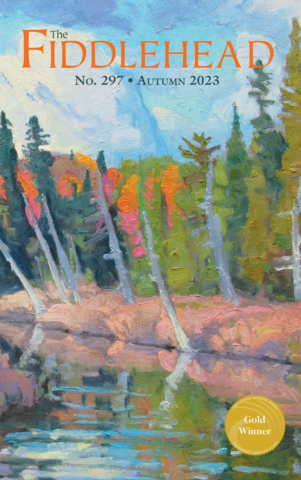
Winner of the 2023 Creative Nonfiction Prize
To dwellers in a wood, almost every species of tree has its voice
as well as its feature.
— Thomas Hardy, Under the Greenwood Tree
Here shall he see / No enemy / But winter and rough weather.
— William Shakespeare, As You Like It
Looking out from his brother’s hospital room, my husband noticed it was raining; it wasn’t until later, leaving the city, that he saw a row of buckled hydro towers and realized something big had happened. Waiting with our daughter’s family an hour and a
half away, I’d been trying to read the sky over cornfields, feeling defenceless in a landscape as open as Dorothy’s Kansas and wondering when we should head for the basement. As it happened, the derecho tracked just north of us as it gouged a thousand-kilometre line across southern Ontario and eastern Quebec. But we were worried about our own house, a half-day’s drive northwest in cottage country, where even under normal circumstances we keep a saw in the car in case a tree falls across our road. I sent a text to a neighbour,
asking for news. She sent a phone pic of the only obstruction on our track: a single, slender poplar. That’s lucky, I replied. We can handle that.
We heard the reports of damage, injury, and death. Our own escape — house, woodshed, solar array unscathed — was so arbitrary as to seem surreal, but we still congratulated ourselves for having had a danger tree near the house cut down the summer before. “If you’re starting to think a tree needs to be taken down,” the arborist had said, “it’s time to take it down.” But none of this held me back from erupting into tears when I saw what our neighbour hadn’t mentioned: a glorious, eighty-foot American basswood, toppled over in the meadow below the house. Can you love a tree? If so, that was the one, the view-defining tree I admired every day, in every season, that I loved truly. Why, among so many acres of trees, was it singled out? Was it to atone for how lightly, as it seemed, the storm had roughed us up otherwise? For the fact that my brother-in-law was beating the odds of a terrible illness? For the uncountable things in my life that could have, but so far haven’t, gone wrong? My husband was surprised at first: such a carry-on for a tree. I agreed, but kept crying regardless.
Before we moved here, I’d never noticed the specific comeliness, the gestalt, of Tilia americana. There are some fine specimens in our clearings: multi-stalked, hence rhythmic; stately and generous; pastoral in evocation. I took them as models of their kind until a friend pointed out that basswoods typically have a single trunk. This would mean that, whether by grazing animal, fire, or axe, those basswoods were pollarded early in their growth, and that the derecho’s victim had already survived a brush with death. In fact, there’d been a second near miss: an infestation of the Lymantria dispar dispar moth, whose caterpillars defoliated nearly 1.8 million hectares of eastern Ontario forests in 2021. A single LDD caterpillar can eat, and excrete, a square metre of greenery before it pupates (it poopates, then pupates), and despite our efforts to bandage the lower trunks with burlap traps, we watched in horror as the mighty basswood was stripped to the last leaf. In our deciduous woods more generally, I felt a miserable anger as the canopy was reduced to thready lace. For the first time I questioned our move to the country: if this was the state of nature now, if it can spiral into ruin so uncontrollably, did I really want to watch at close range? Given the intensity of the infestation, the falling frass sounded like the patter of a fine, refreshing rain — an observation that put a cruel twist on my disgust. (Even the discovery that there is a word for caterpillar shit infuriated me.) We also learned that if a deciduous tree is defoliated early in the season it can remount its leaves and survive. But if this repeats for successive summers it will exhaust itself and die. I watched with faint hope for signs of LDD population collapse — caterpillars turned to ooze, hanging in an inverted V (in which case, nuclear polyhedrosis virus), or shrivelled, hanging vertically (in which case, Entomophaga maimaiga fungus), that would signal the beginning of the end of a multi-year cycle. COVID-weary, I uttered curses that would bring upon the caterpillars their own incurable plague. Some weeks later, our bare basswood took a stab at immortality, performing a second, astonishing leafing-out. There were, indeed, signs of population collapse, but I think it was a prolonged dose of Arctic air that winter that, as well as freezing our water lines, made the spongy egg masses non-viable and reprieved our woods. And so it came to pass that the queen of the basswoods was alive and nearly in full leaf on May 21, 2022, when a low-pressure system west of Lake Eire set in motion the chaos that eventually caught her like a sail, dashing her without mercy to the ground.
Maybe it’s the times, or maybe it’s my age, but I’ve fallen into a habit of anticipating loss, waning, and even erasure, in every lovely, natural thing I have the good luck to gawp at in the day-to-day. I take the measure of our woods and imagine the whole shebang obliterated by wildfire. I sit beside wetlands, watching for ducks and herons, pondering the inexorable advance of Phragmites australis, an out-of-place, habitat-choking reed. I try to discipline these thoughts, to redirect them toward the necessity and productiveness of change, such as the resurgence in our sandy clearings of the native white pine hurled down a century and a half ago by settlers. I think of the carbon storage that, by mindful neglect, we might achieve here. But it’s also true that I had never admired the basswood tree without speculating about which of us would outlast the other. Truly, not once.
Now I know.
Or maybe I don’t. A few roots are still anchored where the tree was tipped out of the mound of sandy earth and cleared fieldstone where it grew. Perhaps the derecho brought about another pollarding, and nothing more. I doubt it, but it might be too soon to tell. The only thing I know right now is that a groundhog likes to survey its kingdom from the top of the root ball, and also, when alarmed, to take cover in a new burrow underneath.
*
So much for the tree. As for the forest, it took us a long time to inspect every corner of our rough ground for damage. Some spots are accessible only in winter, when travelling on snowshoes makes it possible to weave through a confusing, fractal system of wetlands without losing your mind. A drone would have come in handy. It was soon obvious, though, that the path to our kayak-launching spot would have to be remade. This area has always been prone to wind damage, but this time the wind-snaps and blowdowns were more dramatic than we’d ever seen. Ditto for other places where we often see balsam and spruce splintered like exploded firecrackers after a high wind, of which there are plenty in summer. Our woods are tired looking, rather threadbare, a little rickety, and the pruning carried out by any strong wind is part of the normal order here. But this was wind of a different order, wind that moved like a hurricane, but without rotation, a juggernaut that dropped explosives: downbursts, microbursts, EF1 and EF2 tornadoes.
In our township, the hardest blows were dealt at The Ridge, a dome of good land that has been farmed since the 1860s. Wooded areas were reduced to an agonal twist of broken and scrambled trees, trampled under the boots of a crazed colossus. Once-glorious hardwood rows edging broad fields were left in tatters. A friend, sheltering in her farmhouse when the wind tore through, and not knowing where her beloved dog was hiding, was certain the roof would come off. This fear, although unrealized, was entirely rational. (The dog survived.) Up the road, a cattle farmer had received no warning; the storm bore down when he was out with a bucket of fence staples, doing repairs; he ran into the wind so he could see, and thus dodge, falling trees. He made it home without injury to a collapsed barn and a ruined store of hay. A tiny red-brick church used for prayer on Sundays and euchre on Thursdays remained intact, dwarfed within a stand of tall white pine that had always struck me as fate-tempting; sure enough, some of the crowns snapped — falling on tombstones, though, not the church roof, which must have given the faithful something fresh to ponder. Even a year later, an acquaintance near The Ridge was still limbing and bucking fallen trees. “I lost a thousand,” he told me, adding with particular regret, “A lot of big pine.” Neither of us voiced the obvious: they won’t be restored in our day. Another friend, surveying the damage in his fifty-acre lot, fell and broke his ankle. It took him six hours to crawl through the tangle back to the off-grid cabin where his wife waited; she hadn’t realized until the third hour of his absence that something was wrong. The question of where to begin looking for him was unanswerable: a crushed forest is a hellish infinity.
A local logging company made omelettes with broken eggs, harvesting almost nothing but wind-tips and snapped trees until the following spring. Preparing to log in the concession below ours, they smoothed out the road allowance that runs along our south edge. One Sunday afternoon in winter, when there was no truck traffic, we took advantage of the easier walking to have a look. A neighbour working at his hunt camp told us that another neighbour’s hundred acres were gone. “How do you mean, gone?” we said. “Gone,” he repeated. “Just gone.”
Deforesting, we knew about. This was unforesting.
We thought we might as well check our east, rarely travelled, property line to see how things looked there and whether any of the survey tape that marked it needed replacing — a task worth attention every few years. Some of those flags, it turns out, will never be seen again — a sizable section of conifers got clobbered, and even with a heavy snowpack to lift us above much of the debris, it was impossible to get through. A jumble of balsam had evidently made good shelter for hares and good hunting for marten. But I doubt anything bigger than a fox would bother to traverse that mess. Near the same area, a trail we’d made with considerable effort the summer before to a sunwarmed backrest of rock beside a pond was well and truly buried. The wind had taken a wrecking-ball to paradise.
Two months after the derecho, on July 25, a supercell tornado travelled more than fifty-five kilometres through some townships south of us, crushing barns and houses and doing bizarre things to trees. Whereas drone footage of the derecho damage shows downed trees lying like iron filings in an identical direction, the tornado produced an unmethodical and ghoulish mangling. Among fallen hardwoods, white pines were left standing, shorn of branches, as if a harvester machine had malfunctioned, given up, and stuck the mutilated trunks back in the ground. I’ve heard a meteorologist make a respectable argument that derechos are not necessarily more frequent in our region than they used to be. Or at least, given current practices of surveillance, we can’t make meaningful comparisons with the past. Land surveyors in the mid-1800s noted evidence of old hurricanes in these parts. I know a woman whose family farm was obliterated — and a childhood friend killed — in a tornado that touched down in our township in 1947. And yet, standing open-mouthed before the derecho wreckage, and then the centrifuged properties an hour south, it’s hard not to think of these disasters as connected to one another and to the shame of the rapidly unfolding climate-change clusterfuck for which we are to blame.
One day soon we’re going to get tarps ready to hang at a moment’s notice inside the windows of our unshuttered, uncurtained, and basement-less house. We want to be ready for the next whackadoodle storm warning, to protect ourselves from side-bursts of shattered glass.
— Anne Marie Todkill’s story “The Makeweight Piece” won The Fiddlehead’s 2021 fiction contest and appeared in issue no. 291. Her book of poetry, Orion Sweeping (Brick Books), was shortlisted for the 2023 Gerald Lampert Memorial Award. “Storm Damage” is from a collection of essays in progress.
To read the full essay, order your copy of Issue 297 Autumn 2023.










